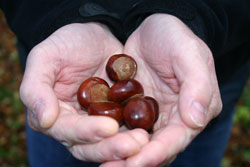University of Reading striving to cure disease that's threatening the conker
Release Date 07 October 2011

This Sunday, teams from around the globe aim to be the toughest nuts to crack by competing in the annual World Conker Championships.
However a new disease could one day threaten the competitors' supply of ammunition and lessen the playground fun had by schoolchildren everywhere.
Dr Rob Jackson from the University of Reading's School of Biological Sciences explains how Reading is helping to conquer bleeding canker disease:
"The horse chestnut has become an iconic sight in Britain since its introduction in the 1500s but in 2002 a new lethal disease appeared that now infects over 70 per cent of trees in some areas. Bleeding canker, caused by the bacterium Pseudomonas syringae pathovar aesculi (Pae), causes lesions which bleed like open sores and in severe cases can kill large mature trees within one to two seasons.
"So how do we cure trees of bleeding canker disease?
"If these trees were humans, we would hope that our immune system could cope with it or give them antibiotics to clear up the infection. Unfortunately, the tree's immune system seems to be too weak to withstand these attacks and the use of antibiotics is banned to stop the spread of antibiotic resistance. Another approach would be to breed trees that are resistant to the germ, but this could take tens of years to develop.
"At Reading, we are adopting a novel approach, which is to explore the use of an antimicrobial compound produced in nature and found everywhere in the environment: bacteriophage. Also known simply as phage, these are viruses that infect bacteria. The beauty with phage is that they can only infect very specific bacteria and thus pose no threat to humans, animals or plants - they don't even harm related bacteria!
"The Natural Environment Research Council, with industrial sponsorship from Bartletts Tree Experts, is funding Reading PhD student Sarah James to isolate phage that targets the bleeding canker germ. Sarah is aiming to look at how many different types of phage exist and then breed different versions that target the bacteria.
"The reason for doing this is that bacteria can develop resistance to phage similar to what happens with antibiotics. Bacteria, however, might resist one type of phage, but would be overcome if it encountered 3 or 4 types.
"Once Sarah has developed new phage types, she will be aiming to treat infected trees in experimental plots, to determine whether her new antimicrobial therapy can help to save our Horse Chestnuts."
